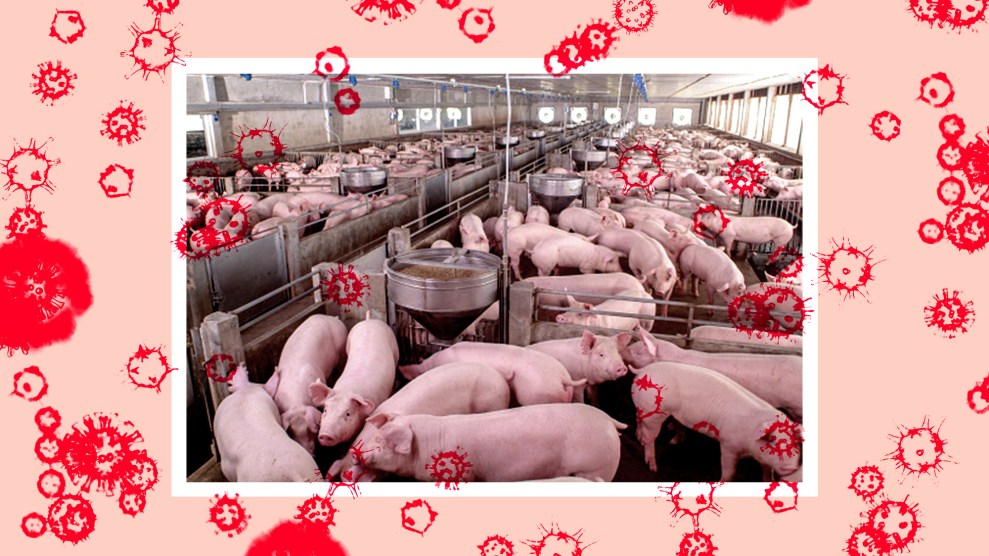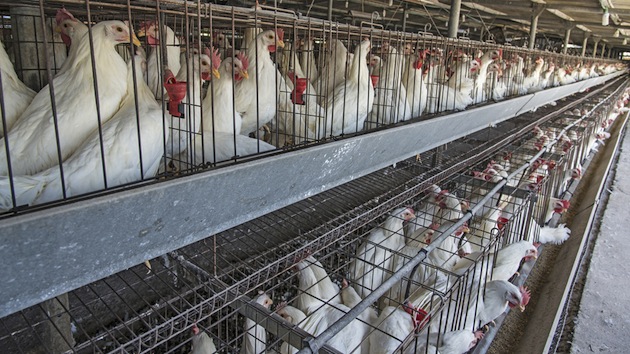
Yeye Weller
If you’re like me, you associate pork with the deliciousness of bacon. But lurking behind the pleasure lies something much less savory to think about: the risk of another pandemic.
That’s because humans and pigs easily swap influenza viruses. Worse still, pigs can also pick up influenza strains that circulate among birds, whose viruses aren’t well adapted to infecting and spreading among people. Humans don’t have the receptors in our throats and noses that avian flus can easily attach to. Our isolation from avian flus is what makes them dangerous—since our immune systems rarely encounter them, we have little innate ability to fight them off. Enter pigs. They can catch flu strains from birds (often carrying them without symptoms), mash them up with genetic material from human-adapted flus, and create novel varieties capable of flummoxing human immunity and generating pandemics. That’s why virologists call hogs “mixing vessels” for novel influenza strains.
In 2009, just such a flu—a new strain of H1N1—emerged from an industrial hog farm in Mexico, combining individual gene segments from humans, birds, North American pigs, and Eurasian pigs. It spread worldwide, inspiring the World Health Organization to declare a pandemic, the first time it had done so since 1968. This strain of H1N1 didn’t prove as virulent as health officials first feared, but even so, it killed more than 284,000 people around the world, including at least 12,000 Americans, and still circulates today. The crisis temporarily gutted demand for US pork, both domestically and abroad, and the Department of Agriculture raced to shore up the industry by buying about $230 million worth of pork to distribute in aid programs.
It was no coincidence an enormous hog operation was the culprit. Humans domesticated pigs at least 9,000 years ago, and we’ve probably been swapping flus with them ever since. But for almost that entire history, hog farming was essentially a backyard activity, with few animals per operation, and broad genetic diversity in the pig population. That diversity meant some pigs would carry a genetic mutation that could block a particular pathogen, an “immune firebreak to keep the virus from going from hog to hog or barn to barn,” says Rob Wallace, an evolutionary biologist with the Agroecology and Rural Economics Research Corps, and author of Big Farms Make Big Flu.
All of that changed in the early 1980s, when US hog farming got supersized. In 1982, 330,000 farms raised 55 million hogs. By 2017, just 66,000 farms were churning out more than 72 million genetically similar pigs. Nearly 80 percent of those hogs were raised on the 3,600 largest US operations, each averaging more than 14,000 animals.
Richard Webby, professor of infectious diseases at St. Jude Children’s Research Hospital and director of a WHO group that studies animal flus, put it like this: It’s a “numbers game. These viruses throw out mutations every time they replicate, so the more chances the virus gets, the more interactions with humans, it increases the chance that one day the stars will align in the right order, the virus will get the right mutation, and take off.”
As if trying to boost those odds, the US livestock industry has chosen to place mammoth numbers of chickens in the very regions where hog farming is most concentrated. Iowa leads the nation in both pig (23 million) and laying-hen (56 million) populations, while also housing nearly 12 million turkeys. Meanwhile, in North Carolina, neighboring Sampson and Duplin counties are home to about 1,200 large hog operations and nearly 800 industrial-scale poultry farms—with more popping up every year.
It doesn’t have to be this way. In February, Sen. Cory Booker (D-NJ) rolled out the Farm System Reform Act, which would place a moratorium on new and expanded factory-scale livestock facilities and devote $10 billion over a decade to promoting pasture-based models involving fewer animals. The bill has zero chance of passing in the current Congress, and faces an uphill climb anyway, given the power of the $296 billion meat industry. But such reform proposals offer a path to a future that should be broadly popular: one where we can enjoy our bacon—albeit less of it—without ramping up the risk of unleashing the next pandemic pathogen.

















